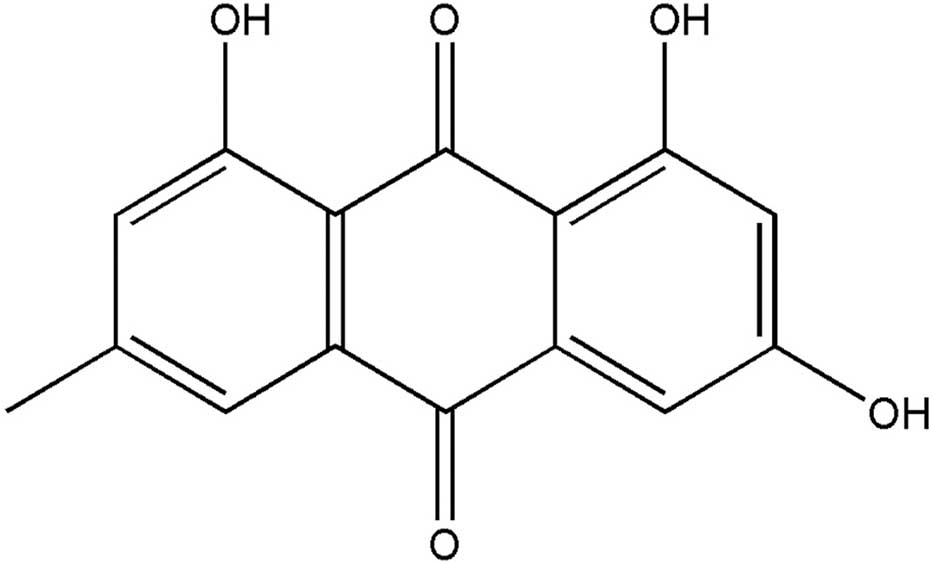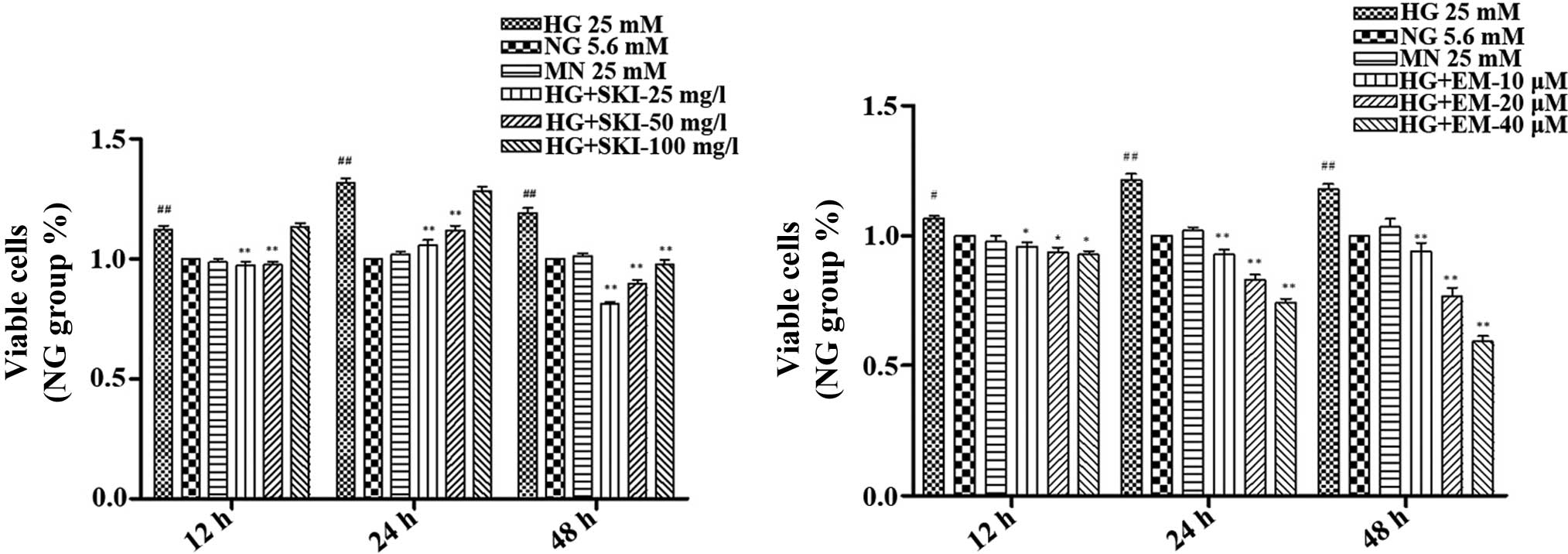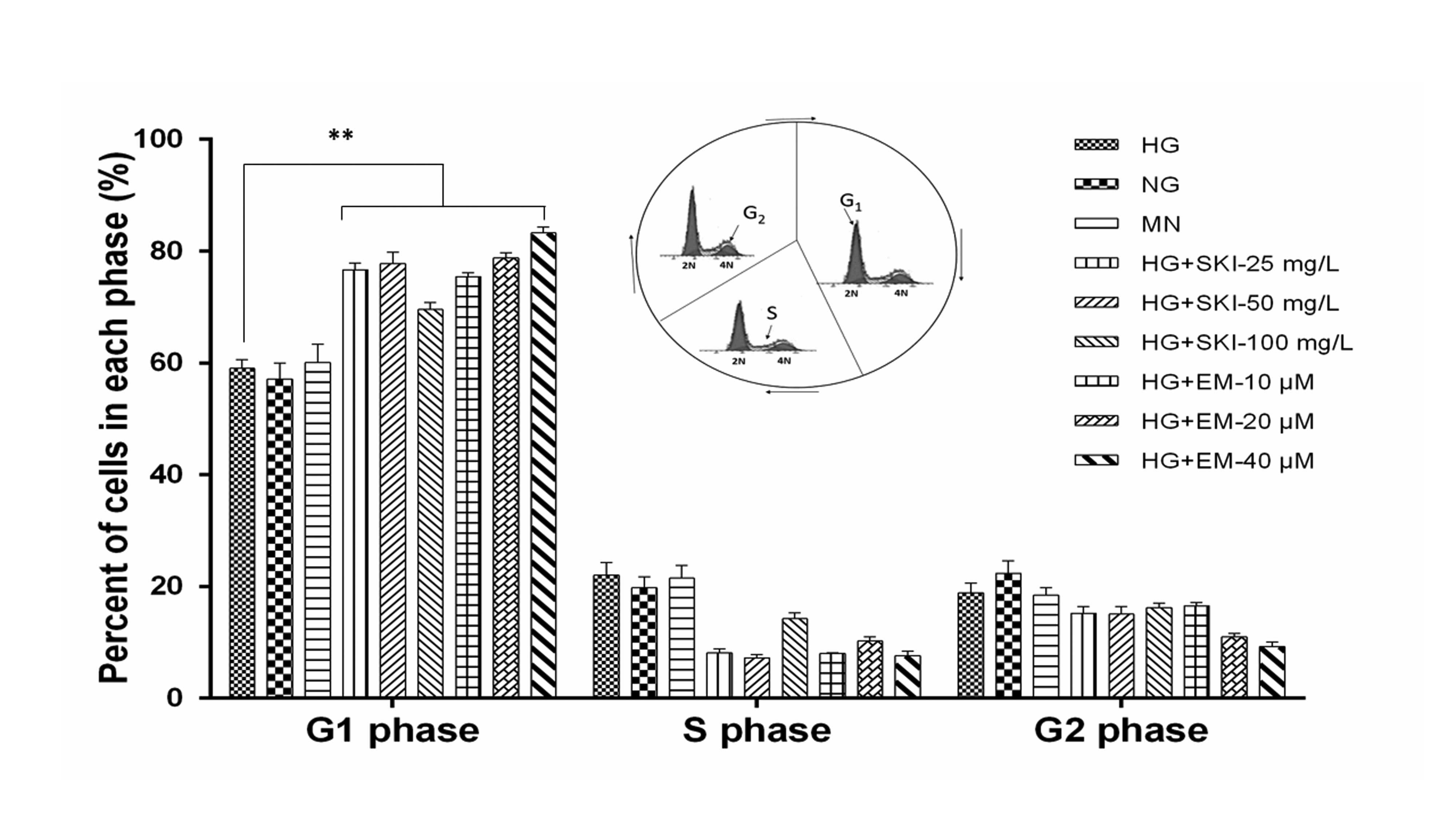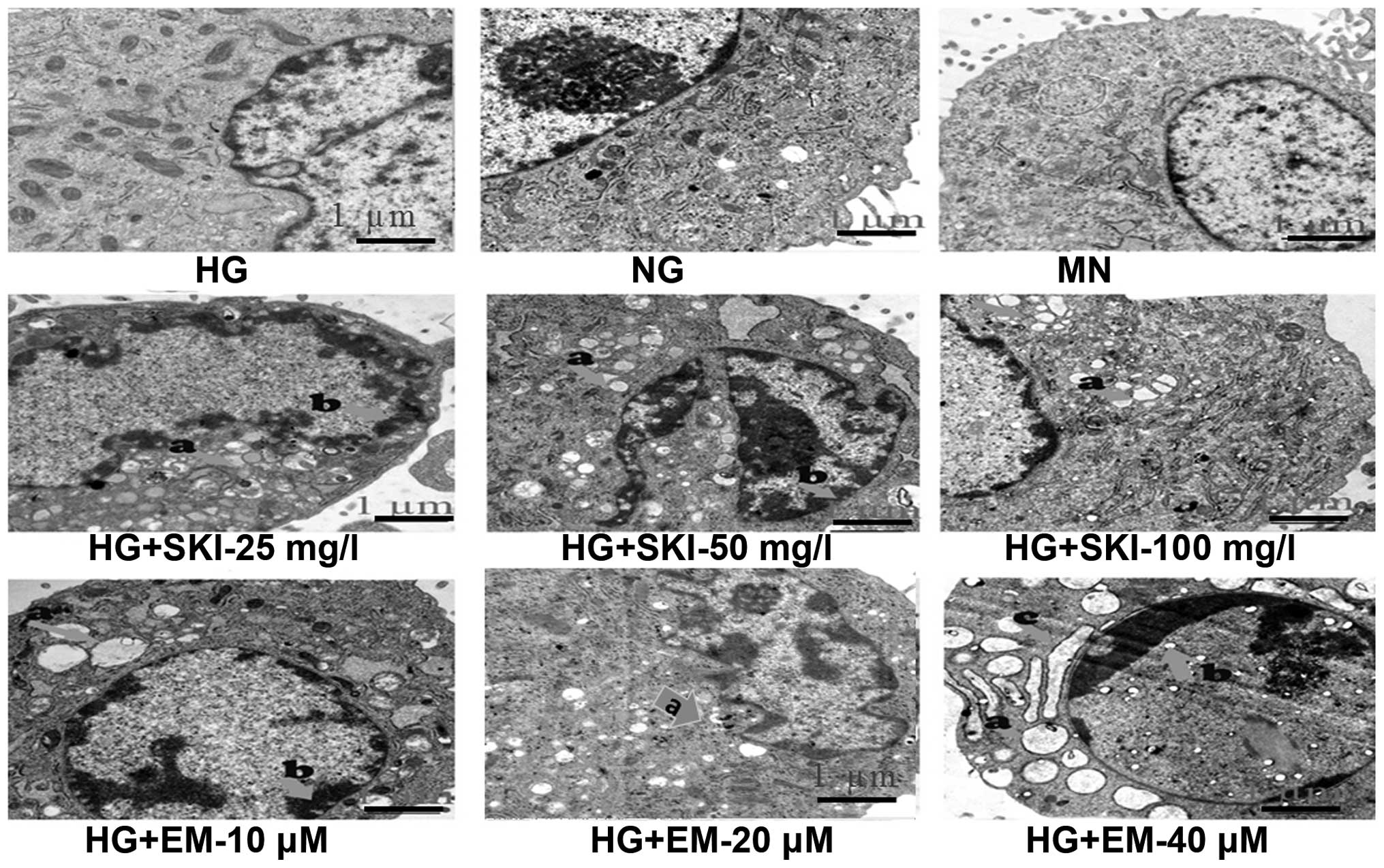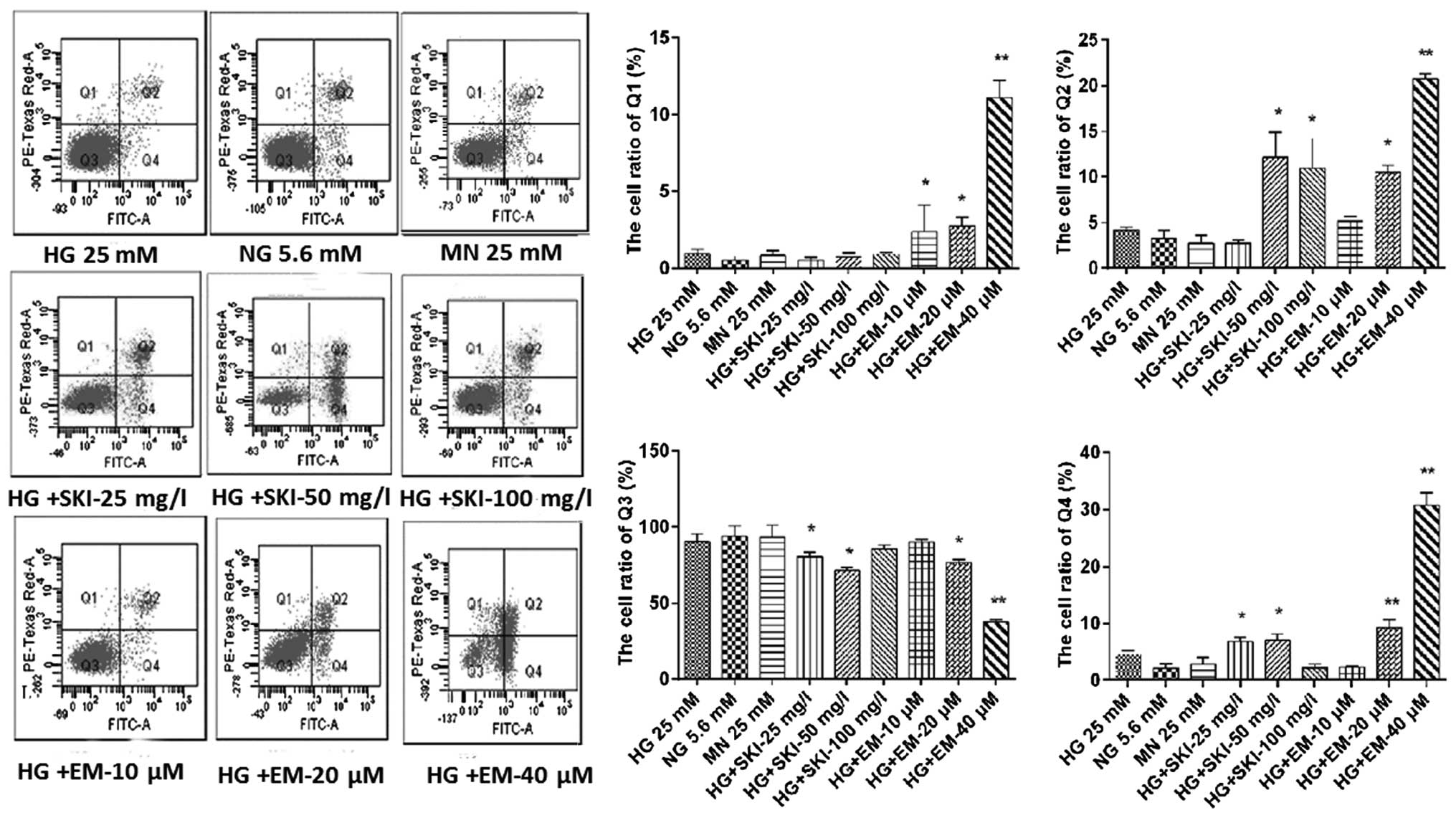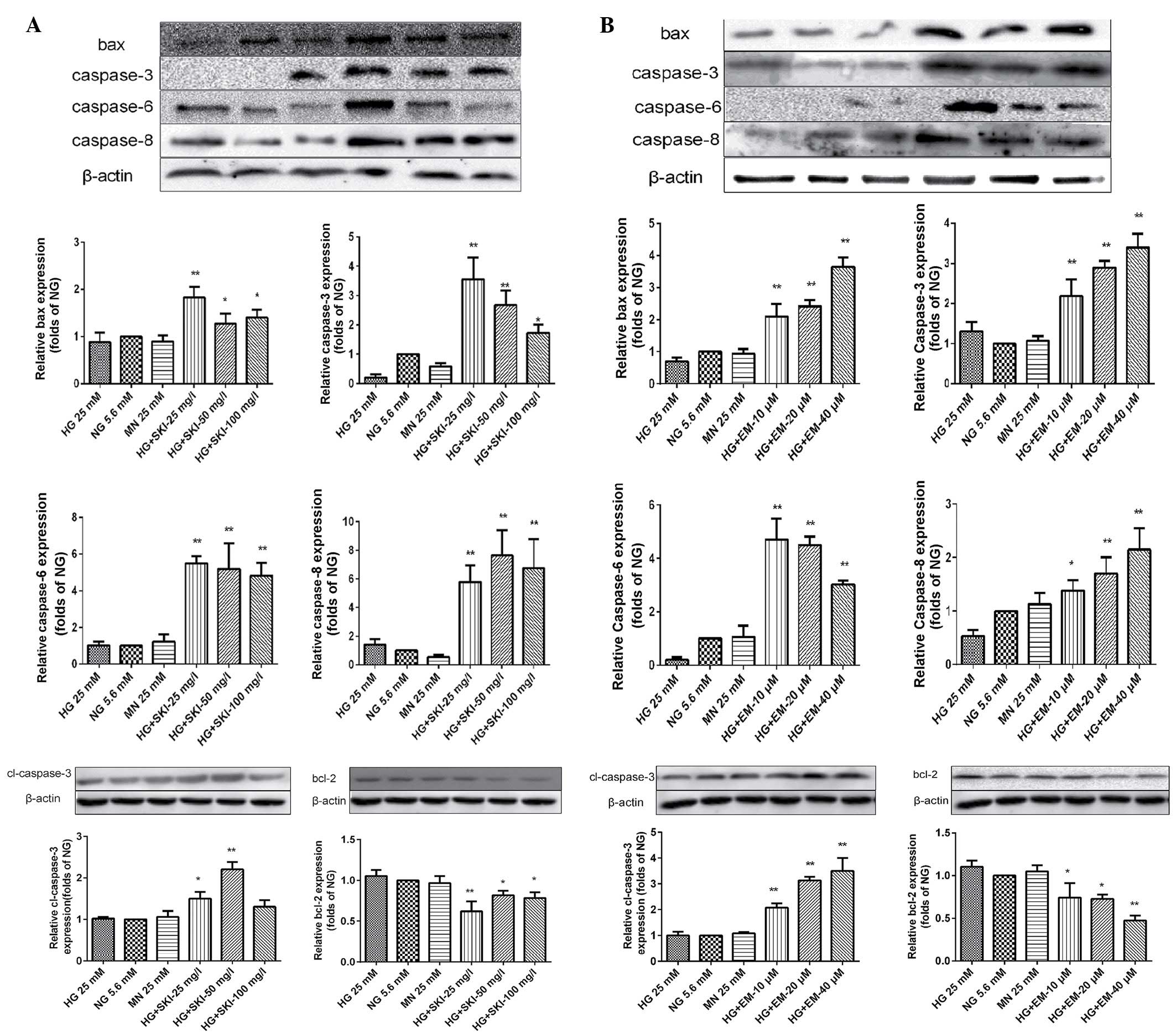Inhibitory effects of Shenkang injection and its main component emodin on the proliferation of high glucose‑induced renal mesangial cells through cell cycle regulation and induction of apoptosis
- Authors:
- Published online on: August 12, 2016 https://doi.org/10.3892/mmr.2016.5631
- Pages: 3381-3388
Abstract
Introduction
Diabetic nephropathy (DN) is one of the most severe microvascular complications of type I and II diabetes, and is a major cause of end-stage renal disease (1). One major pathological feature of DN is increased proliferation of renal mesangial cells (RMCs). Although the precise mechanism underlying the onset and progression of DN has not yet been elucidated, several in vivo studies have demonstrated a significant association between RMC expansion and early stages of DN. Specifically, these studies showed that hypercellularity in the mesangial cell population precedes expansion of the extracellular matrix (ECM) and glomerular sclerosis (2,3). Proliferation of RMCs is also correlated with the degree of glycemic control, indicating that abnormally high blood glucose levels may be a crucial risk factor triggering DN (4). Few studies have explored effective strategies for pharmacological intervention of DN, and there is a critical need to identify drugs with the potential to inhibit or control excessive proliferation of RMCs and thus serve to impede the progression of DN.
Shenkang injection (SKI) is a patented Chinese medicine, which is an extract composed of Rheum officinale, Salvia miltiorrhiza, Carthamus tinctorius and radix Astragali, and is used to treat chronic renal failure (5). Several clinical reports have shown that SKI can inhibit the production of factors that either promote the synthesis of ECM (transforming growth factor-β1 and connective tissue growth factor) or antagonize pathways responsible for the degradation of ECM (tissue inhibitor of metalloproteinase-1 and plasminogen activator inhibitor-1) in the kidney (6). A clinical study showed that SKI treatment significantly improved the clearance rate of serum creatinine (7), while another study showed that in patients diagnosed with early DN, SKI treatment significantly reduced the levels of the urine protein β2-microglobulin (8).
In the combined herbal medicine SKI, rhubarb is the main ingredient, while emodin (EM; 3-methyl-1,6,8-trihydroxy anthraquinone) (Fig. 1) is one of the major active components. The present study aimed to assess whether SKI or EM are suitable for the treatment of diabetic nephropathy. In vivo studies showed that EM significantly decreased the levels of blood glucose, triglycerides and total serum cholesterol, while improving glucose tolerance and insulin sensitivity (9–11). Furthermore, following administration for eight weeks, renal lesions in rats were significantly ameliorated and the levels of serum creatinine, urea and 24-h urine protein were decreased (12). In vitro, EM markedly suppressed high glucose-induced cell proliferation, reduced the expression of fibronectin and collagen IV, decreased the phosphorylation of p38 mitogen-activated protein kinase and upregulated the expression of peroxisome proliferator-activated receptor γ (13,14).
The present study assessed the effects of SKI and EM on the pathology of DN and investigated the underlying mechanisms. Specifically, the anti-proliferative and apoptotic effects of SKI and its major component EM on high glucose-stimulated renal mesangial cells (RMCs) were assessed.
Materials and methods
Cell culture and reagents
The well-characterized rat RMC line HBZY-1 was obtained from The Chinese Center for Type Culture Collection (Wuhan, China). Cells were cultured in Dulbecco's modified Eagle's medium (DMEM; containing 5.6 mM or 25 mM glucose; Thermo Fisher Scientific, Inc., Beijing, China) supplemented with 10% fetal calf serum (FCS; Zhejiang Tianhang Biotechnology Co., Ltd., Zhejiang, China), 10,000 U/ml penicillin and 10,000 µg/ml streptomycin (Thermo Fisher Scientific, Inc.) at 37°C in a humidified atmosphere containing 5% CO2. RMCs between passages 3 and 10 were used for all experiments. Following pre-incubation in DMEM (containing 5.6 mM glucose) supplemented with 0.1% FCS for 24 h, cells were divided into the following experimental groups: Normal glucose (NG; 5.6 mM glucose); high glucose (HG; 25 mM glucose); high glucose and different concentrations of SKI (HG + SKI-100 mg/l, 25 mM glucose + 100 mg/l SKI; HG + SKI-50 mg/l, 25 mM glucose + 50 mg/l SKI; HG + SKI-25 mg/l, 25 mM glucose + 25 mg/l SKI); high glucose and different concentrations of EM (HG + EM-40 µM, 25 mM glucose + 40 µM EM; HG + EM-20 µM, 25 mM glucose + 20 µM EM; HG + EM-10 µM, 25 mM glucose + 10 µM EM); mannitol (MN; 5.6 mM glucose and 19.4 mM mannitol). Mannitol was purchased from Sigma-Aldrich (St. Louis, MO, USA). SKI (0.3 g/ml) was supplied by Xi'an Shiji Shengkang Pharmaceutical Industry Co., Ltd. (Xi'an, China) and the presence of EM was confirmed using high-performance liquid chromatography. EM was purchased from the National Food and Drug Testing Institute (Beijing, China).
Cell proliferation assay
A 3-(4,5-dimethylthiazol-2-yl)-2,5-diphenyltetrazolium bromide (MTT) assay was used as a qualitative index of cell viability. All cells were treated with 20 µl MTT (5 mg/ml; Invitrogen; Thermo Fisher Scientific, Inc., Waltham, MA, USA) after 12, 24 or 48 h of culture under the different experimental conditions stated above, and further cultured for another 4 h. Next, they were lysed using dimethylsulfoxide (0.15 ml/well; Sigma-Aldrich). Once the formazan crystals dissolved completely, the optical density was measured at 490 nm using a Microplate Reader Model M680-UV Spectrophotometer (Bio-Rad Laboratories, Inc., Hercules, CA, USA).
Cell cycle analysis
The cell cycle distribution of cells in the different treatment groups was analyzed using flow cytometry. After 24 h of culture under the different experimental conditions, (0.5–1)×106 cells were harvested by enzymatic digestion with trypsin, washed twice with phosphate-buffered saline (PBS) and fixed in 70% ethanol at 20°C. The fixed cells were re-suspended in 500 µl PBS and RNase A (100 µg/ml; Takara Bio, Inc., Otsu, Japan) and incubated at 37°C for 1 h. Next, the cells were treated with propidium iodide (PI; 50 µg/ml; Takara Bio, Inc.) for 30 min. The DNA content of 2×105 cells from each experimental group was determined using a flow cytometer (LSRFortessa; Becton Dickinson, San Jose, CA, USA), and the data were analyzed using Mod Fit LT 2.0 software (Verity Software, Topsham, ME, USA).
Apoptosis assay
Apoptotic cells were identified using an Annexin V/PI apoptosis kit (Keygen Biotech, Nanjing, China) and flow cytometry. After 24 h of culture under the different experimental conditions, (0.5–1)×106 cells were harvested and re-suspended in 500 µl binding buffer. Next, the cells were incubated with 5 µl Annexin V-fluorescein isothiocyanate (FITC) and 5 µl PI (50 mg/ml) for 15 min in the dark and immediately analyzed by flow cytometry. Data from at least 2×105 cells of each sample were acquired and analyzed using Cell Quest software, version 7.5.3 (Becton Dickinson). In the PI vs. FITC scatter plot, the percentage of cells in the lower right quadrant of (early apoptotic cells), upper right quadrant (late apoptotic cells), upper left quadrant (necrotic cells) and lower left quadrant (live cells) was calculated for comparison.
Transmission electron microscopy (TEM)
To further assess the occurrence of apoptosis, the morphology of the cells was observed by TEM. After 24 h of culture under different experimental conditions, cells were collected by centrifugation (1,080 × g, 3 min), washed twice with PBS and fixed in freshly made 1% paraformaldehyde with 2% glutaraldehyde (Wuhan Boster Biological Technology, Ltd., Wuhan, China) for 24 h. Next, the samples were treated with 1% osmium tetroxide (Beijing CoWin Biotech Co., Ltd., Beijing, China) for 2 h, dehydrated using a graded ethanol series and embedded in araldite. Ultra-thin sections were prepared, stained with uranyl acetate (Shanghai Jianglai Biotechnology Co., Ltd., Shanghai, China) and lead citrate and observed by TEM (JEM-101; Jeol Electron Inc, Tokyo, Japan).
Western blot analysis
Cells cultured under the different experimental conditions for 24 h were harvested and washed with ice-cold PBS. Whole-cell protein extracts were obtained by lysing the cells with radioimmunoprecipitation assay lysis buffer (Beyotime Institute of Biotechnology, Haimen, China). Protein concentrations were determined using the bicinchonic acid method (Beyotime Institute of Biotechnology). Total proteins (50 µg/lane) were then separated by 10% sodium dodecyl sulfate polyacrylamide gel electrophoresis, transferred onto nitrocellulose membranes (0.45 µm; Bio-Rad Laboratories, Inc.) and blocked with 5% skimmed milk in Tris-buffered saline (pH 7.6; TBS) at room temperature. The membranes were then incubated overnight at 4°C with primary antibodies against B-cell lymphoma 2 (bcl-2)-associated X protein (bax; rabbit monoclonal; 1:2,000 dilution; cat. no. ab32503; Abcam, Cambridge, MA, USA), bcl-2 (rabbit monoclonal; 1:1,000 dilution; cat. no. ab32124; Abcam), caspase-8 (rabbit polyclonal; 1:2,000 dilution; cat. no. ab25901; Abcam), caspase-6 (rabbit monoclonal; 1:1,000 dilution; cat. no. P55212; Epitomics; Abcam), caspase-3 (rabbit monoclonal; 1:1,000; cat. no P42574; Epitomics; Abcam), cleaved caspase-3 (rabbit monoclonal; 1:500 dilution; cat. no. AC033; Beyotime Institute of Biotechnology) and β-actin (rabbit polyclonal; 1:1,000; cat. no. AP0060; Bioworld Technology, Inc., St. Louis Park, MN, USA). Subsequent to washing with TBS three times, the membranes were incubated with the anti-rabbit or anti-mouse IgG antibodies conjugated with horseradish peroxidase (1:2,000 dilution; Beyotime Institute of Biotechnology) for 1.5 h at room temperature. Subsequent to washing the membranes three times, the resulting immune complexes were detected using enhanced chemiluminescence kits (Thermo Fisher Scientific, Inc.). Immunolabeled bands were further quantified using the Gel Doc™ XR and Lab image 4.0.1 software (Bio-Rad Laboratories, Inc.). All values were normalized to the absorbance of the internal control (β-actin).
Statistical analysis
Differences between experimental groups were tested for statistical significance using one-way analysis of variance followed by Tukey's test. GraphPad Prism, version 6.0 (GraphPad Software, Inc., La Jolla, CA, USA) was used for the analysis. All values are expressed as the mean ± standard deviation. P<0.05 was considered to indicate a statistically significant difference between values.
Results
SKI and EM inhibit RMC proliferation induced by HG
To determine the effects of SKI and EM on the proliferation of RMCs under normal glucose conditions, an MTT assay was performed, revealing that the drugs did not affect RMCs (Fig. 2). Next, the effects of SKI and EM on RMCs cultured under HG conditions were assessed (Fig. 3). The results showed that in comparison to the NG group, 25 mM glucose (HG) increased the proliferation of RMCs after 12, 24 and 48 h of culture, which was significantly inhibited by treatment with 25 and 50 mg/l SKI. However, a concentration of 100 mg/l SKI only significantly inhibited the HG-induced increase in cell division at 48 h. In addition, EM dose- and time-dependently inhibited HG-induced RMC proliferation at concentrations of 10, 20 and 40 µM. Finally, exposure to 25 mM mannitol, an osmotic control, did not alter the growth rate of the RMCs. This suggested that HG-induced RMC proliferation was not a consequence of high osmolarity (Fig. 3).
SKI and EM inhibit cell cycle progression of RMCs stimulated by HG
To further evaluate the mechanisms of the anti-proliferative effects of SKI and EM, flow cytometric cell cycle analysis of cells in the various treatment groups was performed. As shown in Fig. 4, in comparison to the HG group, treatment with 25, 50 or 100 mg/l SKI increased the G1 phase population from 59.0±1.6 to 76.6±1.2, 77.7±2.1 and 69.5±1.3%, respectively. EM dose-dependently inhibited cell cycle progression, as treatment with 25, 50 and 100 mg/l EM led to an increase in the percentage of cells in G1 phase to 75.4±0.7%, 78.8±0.9% and 83.2±1.1%, respectively. In addition, it was observed that in comparison with the MN and NG groups, HG conditions promoted cell cycle progression (G1, 58.0±0.2%; S, 19.4±0.6%; G2, 22.6±0.4%). There was no notable difference between the MN and NG groups, suggesting that changes in cell cycle progression triggered by HG were not a result of the high osmolarity in HG cultures. In conclusion, the results showed that HG conditions promoted cell cycle progression and proliferation of RMCs, which was significantly reversed by SKI and EM by causing G1-phase arrest.
SKI and EM enhance the apoptotic rate of RMCs exposed to HG
Next, the present study assessed whether SKI and EM inhibited the increase in proliferation of RMCs under HG by promoting apoptosis (programmed cell death). To address this question, cellular morphology was first observed by TEM. As shown in Fig. 5, cells in the MN and HG groups did not display any changes in their typical morphology compared to those in the NG group. However, following exposure to different concentrations of SKI and EM for 24 h, obvious morphological changes characteristic for apoptosis were observed in these cells. These typically included chromatin condensation, vacuolization in the mitochondria and degranulation in the endoplasmic reticulum, as indicated in Fig. 5.
To further confirm this observation, flow cytometric analysis of RMCs in the various treatment groups was performed. As shown in Fig. 6, SKI significantly induced either late or early apoptosis in RMCs under HG; furthermore, EM was found to dose-dependently induce apoptosis and necrosis, while dose-dependently reducing the viability of the cells. In addition, there was no obvious increase in cell death in the MN, NG and HG groups.
Finally, western blot analysis was performed to determine which components of the apoptotic pathway are impacted by SKI and EM treatment. Incubation of RMCs with various concentrations of SKI for 24 h under HG led to a significant upregulation of bax, caspase-3, cleaved caspase-3, caspase-6 and caspase-8 (Fig. 7A). Furthermore, EM was found to dose-dependently increase the levels of all of these proteins (Fig. 7B).
All of these results indicated that SKI and EM induced mitochondria-mediated apoptosis in RMCs under HG.
Discussion
SKI is a Traditional Chinese Medicine whose major active component is EM. Although it is widely used to treat DN in China, the precise molecular functions of its components and its mechanism of action have remained to be elucidated. The present study demonstrated the inhibitory effects of SKI and EM on HG-induced proliferation of RMCs. Furthermore, the underlying mechanisms were revealed to comprise inhibition of DNA synthesis resulting from cell cycle arrest in G1 phase, as well as induction of mitochondrial apoptosis in RMCs. Morphological changes in RMCs were observed following exposure to different concentrations of SKI and EM, including chromatin condensation, vacuolization in the mitochondria and degranulation in the endoplasmic reticulum. Furthermore, flow cytometric analysis revealed an increase in the apoptotic rate of RMCs exposed to SKI and EM for 24 h under HG. The underlying molecular mechanism was further elucidated using western blot analysis, revealing an upregulation of the apoptotic proteins bax, caspase-3, cleaved caspase-3, caspase-6 and caspase-8 in addition to downregulation of bcl-2 in RMCs following incubation with SKI and EM. These results revealed that SKI and EM can inhibit HG-induced RMC proliferation by regulating cell cycle progression and inducing apoptosis.
Studies have shown that a proliferative response of RMCs subsequent to a variety of stimuli is associated with matrix accumulation and the development of glomerulosclerosis, which eventually leads to progressive renal disease. HG concentrations were shown to contribute to uncontrolled proliferation of RMCs, distal tubular epithelial cells and vascular smooth muscle cells during diabetes (15–17). The present study used rat RMCs as an in vitro model to study changes in cell proliferation during the early stages of diabetic nephropathy. As clinical trials have demonstrated that HG is the principal cause of renal damage in type I and type II diabetes (18), HG culture conditions were applied to stimulate RMC proliferation.
During cell cycle progression, the transition from G1 to S phase is essential for DNA synthesis, which is followed by G2 phase and finally the M phase, in which mitotic cell division takes place (19,20). In the present study, compared to the NG group, HG conditions significantly promoted cell cycle progression. However, treatment with different concentrations of SKI and EM led to G1-phase arrest. Furthermore, in the MN group the cell cycle distribution was not markedly affected, confirming that HG-associated osmotic pressure was not involved in these effects. These results suggested that HG induces RMC proliferation by promoting cell cycle progression in RMCs, and that SKI and EM can reverse this effect by arresting cells in G1 phase.
Apoptotic cell death is characterized by specific biochemical and morphological changes, which can be identified using several assays, including morphological analysis by high-resolution microscopy, as well as flow cytometry and western blot analysis. In the present study, TEM was used to examine HG-induced RMCs treated with various concentrations of SKI and EM, revealing the following morphological changes: Chromatin condensation, vacuolization in the mitochondria and degranulation in the endoplasmic reticulum. However, the MN, and HG groups did not show any morphological abnormalities compared with the NG group. Flow cytometry was further used to verify the increase in the percentage of apoptotic cells in the SKI and EM groups. The results clearly showed that SKI and EM induced apoptosis in RMCs under HG conditions.
Bax is a pro-apoptotic protein that facilitates apoptosis through an intrinsic, damage-induced pathway, and amplifies apoptotic signaling upregulated via extrinsic, receptor-mediated triggers (21). The effect of bax mediated-apoptosis is largely dependent on the concentration of bax and its inhibitor bcl-2. It is expressed in viable cells and activated in response to pro-apoptotic stimuli. Caspase-3, -6 and -8 are members of a family of cysteine proteases originally discovered for their role in apoptosis. During this process, caspases participate in signaling cascades where the upstream initiator caspases activate the downstream executioner caspases, which in turn cleave a specific subset of cellular targets (22). To elucidate the mechanism of action underlying EM and SKI-induced apoptosis in RMCs, the expression levels of bax, bcl-2, caspase-3, cleaved caspase-3, caspase-6, and caspase-8 were examined by western blot analysis in the present study.
In conclusion, the present study demonstrated that SKI and its major active component EM inhibited HG-stimulated proliferation of RMCs by causing cell cycle arrest at G1 phase and inducing apoptosis. At the molecular level, the underlying mechanism was shown to include upregulation of bax, caspase-3, cleaved caspase-3, caspase-6 and caspase-8, and downregulation of bcl-2. The present study supported the use of SKI and EM for potential use as therapeutics for DN.
References
|
Giunti S, Barit D and Cooper ME: Diabetic nephropathy: From mechanisms to rational therapies. Minerva Med. 97:241–262. 2006.PubMed/NCBI | |
|
Abboud HE: Mesangial cell biology. Exp Cell Res. 318:979–985. 2012. View Article : Google Scholar : PubMed/NCBI | |
|
Danesh FR, Sadeghi MM, Amro N, Philips C, Zeng L, Lin S, Sahai A and Kanwar YS: 3-hydroxy-3-methylglutaryl CoA reductase inhibitors prevent high glucose-induced proliferation of mesangial cells via modulation of Rho GTPase/p21 signaling pathway: Implications for diabetic nephropathy. Proc Natl Acad Sci USA. 99:8301–8305. 2002. View Article : Google Scholar | |
|
Hodgkinson AD, Bartlett T, Oates PJ, Millward BA and Demaine AG: The response of antioxidant genes to hyperglycemia is abnormal in patients with type 1 diabetes and diabetic nephropathy. Diabetes. 52:846–851. 2003. View Article : Google Scholar : PubMed/NCBI | |
|
Ye CH, Wu F, Liu TH and Li MQ: Compound traditional chinese medicine preparation. Chinese Patent CN103768525A. Filed January 17, 2014; issued May 7, 2014. | |
|
QY YC and Rui P: Antagonizing effects of Shenkang Injection on renal interstitial fibrosis in model rat of chronic aristolochic acid nephropathy. Chin Tradit Herb Drugs. 4:587–592. 2009. | |
|
Jiang ZW, Lv YY and Xia JL: The phase clinical observation study of shengkang injection on chronic renal failure. J China Med Univ. 40:941–945. 2011. | |
|
Du J, Chen H and Wang XB: Effect of shenkang injection on hypertrophy and expressions of p21 and p27 in glomerular mesangial cells of rats cultured in high glucose. Chin J Integr Tradit West Med. 26(Suppl): 68–71. 2006.In Chinese. | |
|
Xue J, Ding W and Liu Y: Anti-diabetic effects of emodin involved in the activation of PPARgamma on high-fat diet-fed and low dose of streptozotocin-induced diabetic mice. Fitoterapia. 81:173–177. 2010. View Article : Google Scholar | |
|
Yang LHLF: Effect of emodin and berberine on gastrointestinal motility in type 2 diabetic rats. World Chin J Digestol. 13:607–611. 2005. | |
|
Song B and Liu XZ: Emodin improves insulin sensitivity in KKAy diabetic mice. Chinese PLA Postgrad Med. 32:1274–1276. 2011. | |
|
Wang J, Huang H, Liu P, Tang F, Qin J, Huang W, Chen F, Guo F, Liu W and Yang B: Inhibition of phosphorylation of p38 MAPK involved in the protection of nephropathy by emodin in diabetic rats. Eur J Pharmacol. 553:297–303. 2006. View Article : Google Scholar : PubMed/NCBI | |
|
Liu Y, Jia L, Liu ZC, Zhang H, Zhang PJ, Wan Q and Wang R: Emodin ameliorates high-glucose induced mesangial p38 over-activation and hypocontractility via activation of PPARgamma. Exp Mol Med. 41:648–655. 2009. View Article : Google Scholar : PubMed/NCBI | |
|
Li X, Liu W, Wang Q, Liu P, Deng Y, Lan T, Zhang X, Qiu B, Ning H and Huang H: Emodin suppresses cell proliferation and fibronectin expression via p38MAPK pathway in rat mesangial cells cultured under high glucose. Mol Cell Endocrinol. 307:157–162. 2009. View Article : Google Scholar : PubMed/NCBI | |
|
Arora MK and Singh UK: Molecular mechanisms in the pathogenesis of diabetic nephropathy: An update. Vascul Pharmacol. 58:259–271. 2013. View Article : Google Scholar : PubMed/NCBI | |
|
Zhang L, Pang S, Deng B, Qian L, Chen J, Zou J, Zheng J, Yang L, Zhang C, Chen X, et al: High glucose induces renal mesangial cell proliferation and fibronectin expression through JNK/NF-κB/NADPH oxidase/ROS pathway, which is inhibited by resveratrol. Int J Biochem Cell Biol. 44:629–638. 2012. View Article : Google Scholar : PubMed/NCBI | |
|
Sodhi CP, Phadke SA, Batlle D and Sahai A: Hypoxia and high glucose cause exaggerated mesangial cell growth and collagen synthesis: Role of osteopontin. Am J Physiol Renal Physiol. 280:F667–F674. 2001.PubMed/NCBI | |
|
Suzaki Y, Yoshizumi M, Kagami S, Nishiyama A, Ozawa Y, Kyaw M, Izawa Y, Kanematsu Y, Tsuchiya K and Tamaki T: BMK1 is activated in glomeruli of diabetic rats and in mesangial cells by high glucose conditions. Kidney Int. 65:1749–1760. 2004. View Article : Google Scholar : PubMed/NCBI | |
|
Ye Y, Wang H, Chu JH, Chou GX, Chen SB, Mo H, Fong WF and Yu ZL: Atractylenolide II induces G1 cell-cycle arrest and apoptosis in B16 melanoma cells. J Ethnopharmacol. 136:279–282. 2011. View Article : Google Scholar : PubMed/NCBI | |
|
Li H, Wang P, Liu Q, Cheng X, Zhou Y and Xiao Y: Cell cycle arrest and cell apoptosis induced by Equisetum hyemale extract in murine leukemia L1210 cells. J Ethnopharmacol. 144:322–327. 2012. View Article : Google Scholar : PubMed/NCBI | |
|
Ghibelli L and Diederich M: Multistep and multitask Bax activation. Mitochondrion. 10:604–613. 2010. View Article : Google Scholar : PubMed/NCBI | |
|
Fuentes-Prior P and Salvesen GS: The protein structures that shape caspase activity, specificity, activation and inhibition. Biochem J. 384:201–232. 2004. View Article : Google Scholar : PubMed/NCBI |



